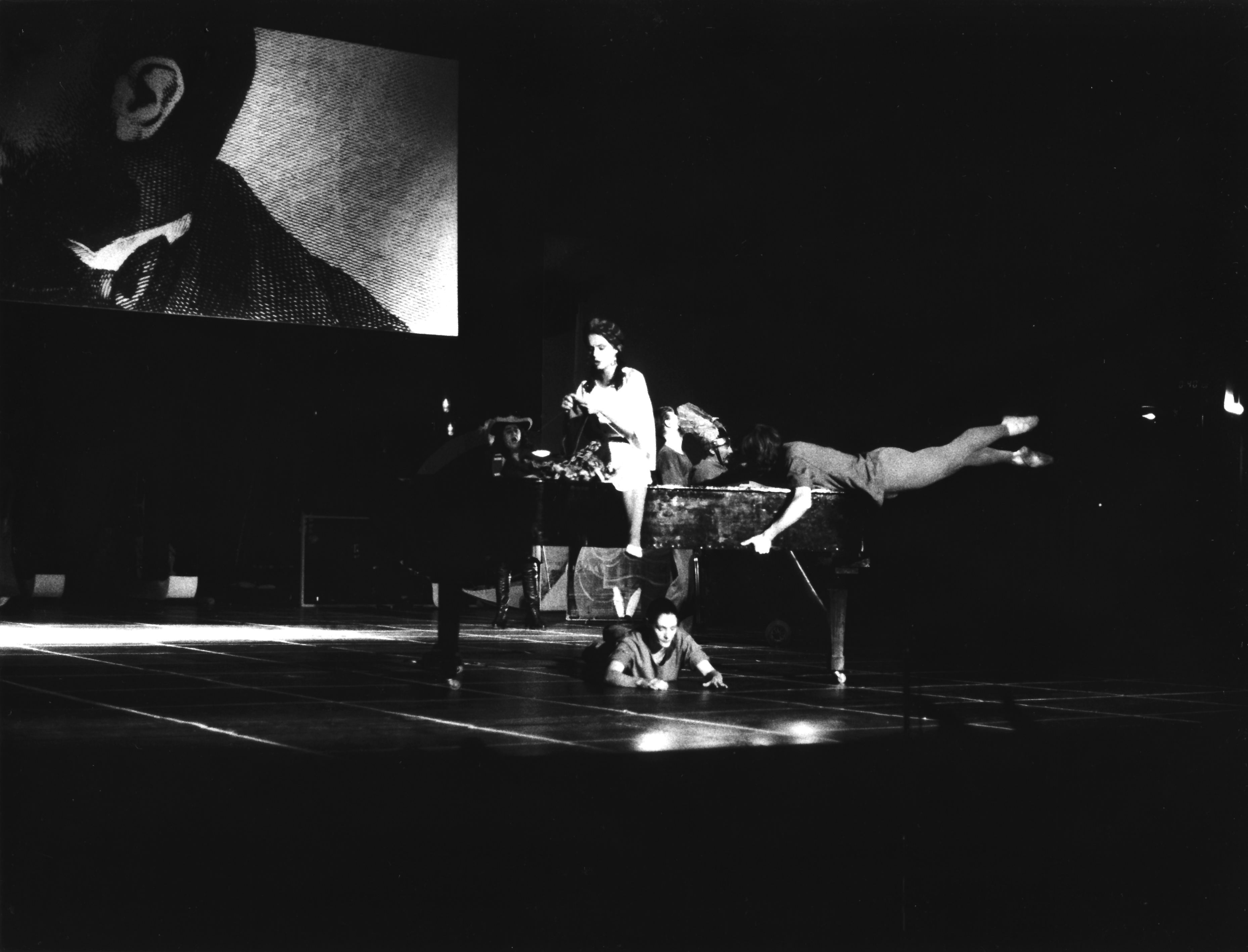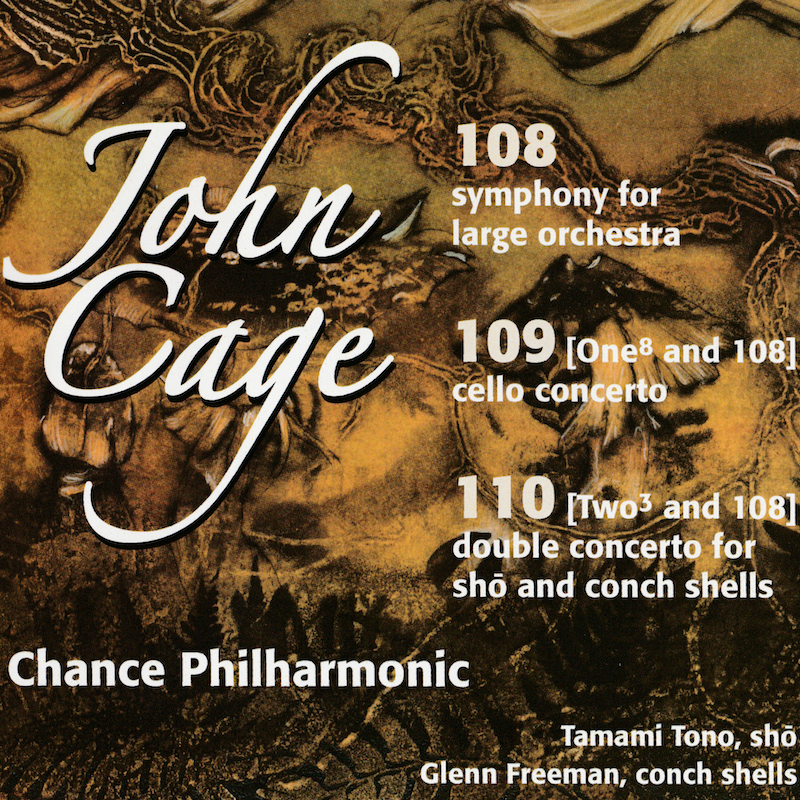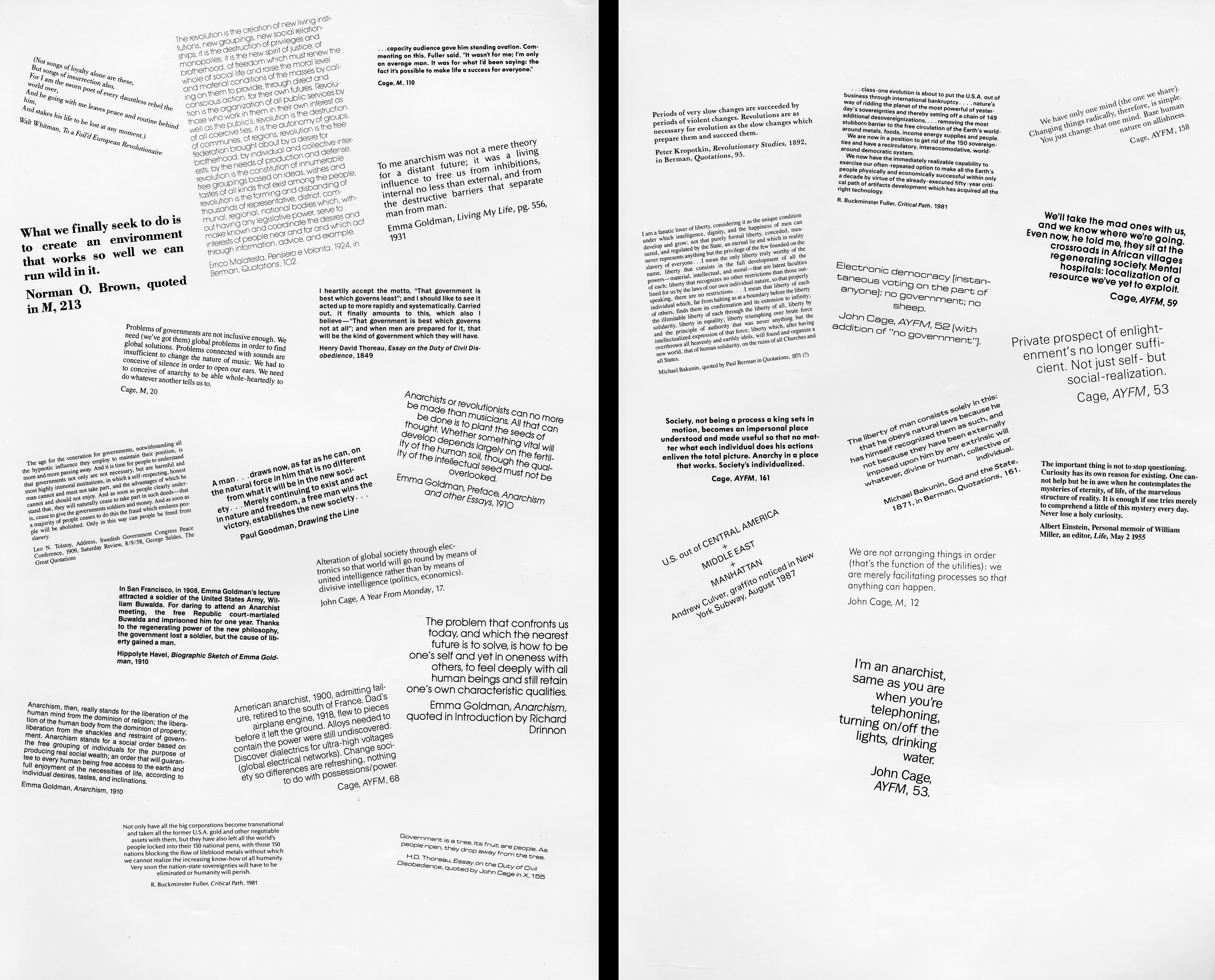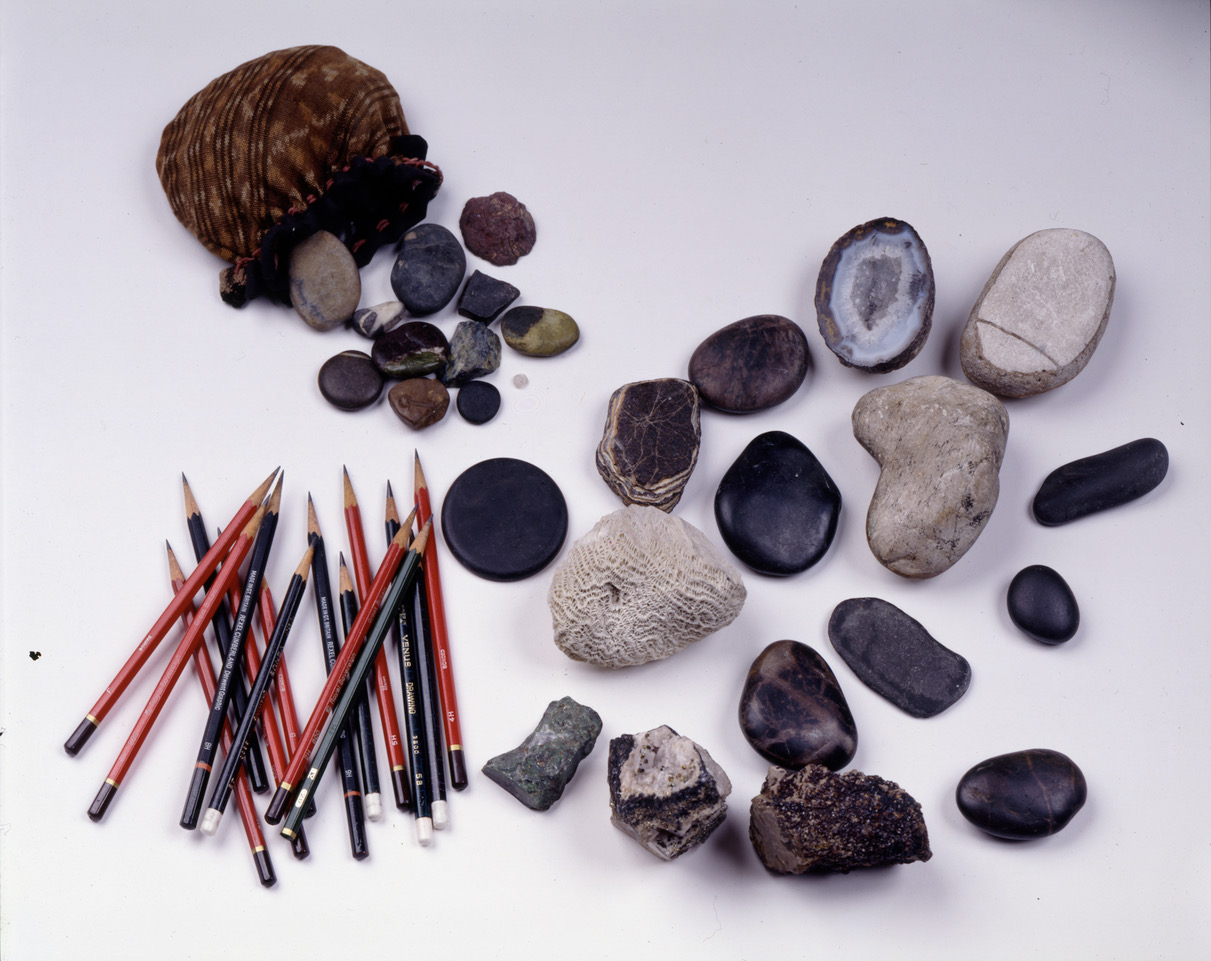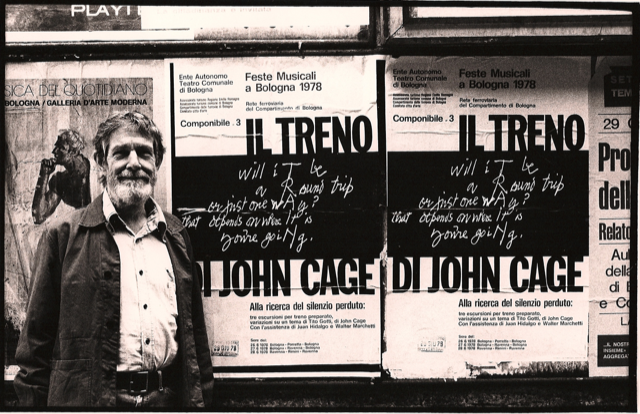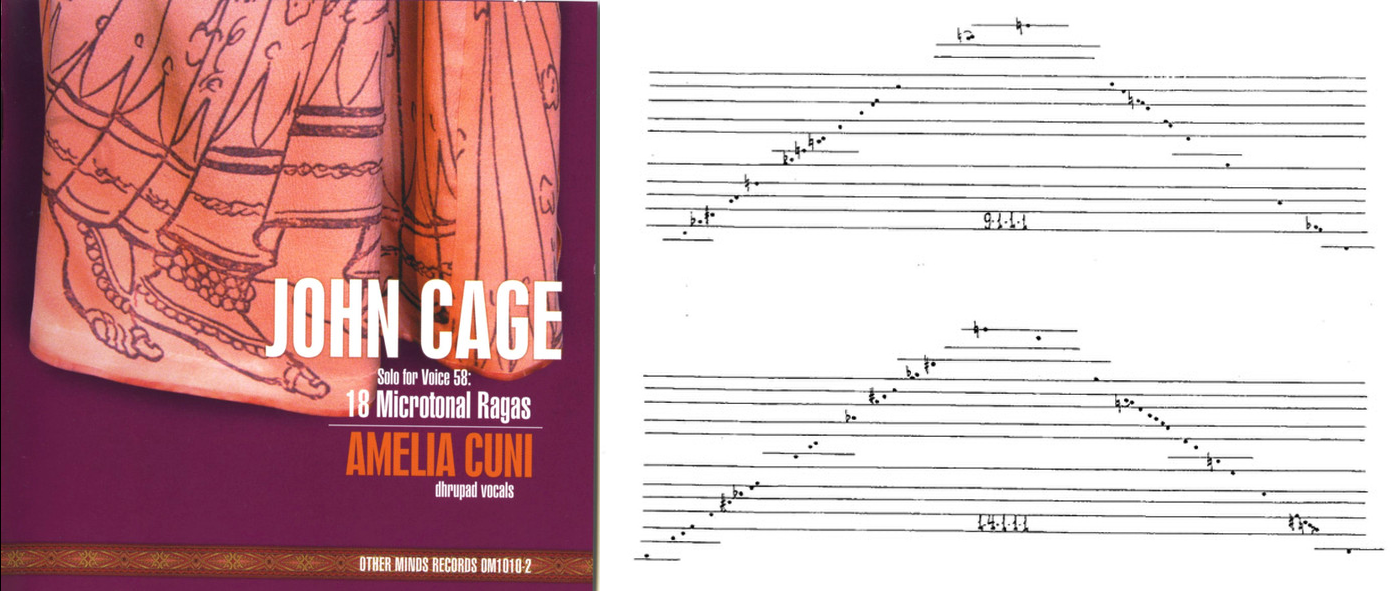TRANSMISSION ART ARCHIVE


John Cage
John Cage (1912 - 1992): An Autobiographical Statement
(reprinted from http://johncage.org)
What follows is John Cage's "Autobiographical Statement"(1990), which, in time, will transform into a fully animated multimedia version. Hyperlinked words will take you to a wealth of materials across media -- some drawn from the archives of the John Cage Trust, some discovered within the folds of the World Wide Web, some newly created. While we work to create these links (both content and access), we ask that you consider submitting for consideration your own contributions, which may take the form of text, video, music, and/or images (files or links). Like our "Folksonomy," this aspect of the website means to infinitely expand.
I once asked Aragon, the historian, how history was written. He said, "You have to invent it." When I wish as now to tell of critical incidents, persons, and events that have influenced my life and work, the true answer is all of the incidents were critical, all of the people influenced me, everything that happened and that is still happening influences me.
My father was an inventor. He was able to find solutions for problems of various kinds, in the fields of electrical engineering, medicine, submarine travel, seeing through fog, and travel in space without the use of fuel. He told me that if someone says "can't" that shows you what to do. He also told me that my mother was always right even when she was wrong.
My mother had a sense of society. She was the founder of the Lincoln Study Club, first in Detroit, then in Los Angeles. She became the Women's Club editor for the Los Angeles Times. She was never happy. When after Dad's death I said, "Why don't you visit the family in Los Angeles? You'll have a good time," she replied, "Now, John, you know perfectly well I've never enjoyed having a good time." When we would go for a Sunday drive, she'd always regret that we hadn't brought so-and-so with us. Sometimes she would leave the house and say she was never coming back. Dad was patient, and always calmed my alarm by saying, "Don't worry, she'll be back in a little while."
Neither of my parents went to college. When I did, I dropped out after two years. Thinking I was going to be a writer, I told Mother and Dad I should travel to Europe and have experiences rather than continue in school. I was shocked at college to see one hundred of my classmates in the library all reading copies of the same book. Instead of doing as they did, I went into the stacks and read the first book written by an author whose name began with Z. I received the highest grade in the class. That convinced me that the institution was not being run correctly. I left.
In Europe, after being kicked in the seat of my pants by José Pijoan for my study of flamboyant Gothic architecture and introduced by him to a modern architect who set me to work drawing Greek capitals, Doric, Ionic, and Corinthian, I became interested in modern music and modern painting. One day I overheard the architect saying to some girl friends, "In order to be an architect, one must devote one's life to architecture." I then went to him and said I was leaving because I was interested in other things than architecture. At this time I was reading Leaves of Grass of Walt Whitman. Enthusiastic about America I wrote to Mother and Dad saying, "I am coming home." Mother wrote back, "Don't be a fool. Stay in Europe as long as possible. Soak up as much beauty as you can. You'll probably never get there again." I left Paris and began both painting and writing music, first in Mallorca. The music I wrote was composed in some mathematical way I no longer recall. It didn't seem like music to me so that when I left Mallorca I left it behind to lighten the weight of my baggage. In Sevilla on a street corner I noticed the multiplicity of simultaneous visual and audible events all going together in one's experience and producing enjoyment. It was the beginning for me of theater and circus.
Later when I returned to California, in the Pacific Palisades, I wrote songs with texts by Gertrude Stein and choruses from The Persians of Aeschylus. I had studied Greek in high school. These compositions were improvised at the piano. The Stein songs are, so to speak, transcriptions from a repetitive language to a repetitive music. I met Richard Buhlig who was the first pianist to play the Opus II of Schoenberg. Though he was not a teacher of composition, he agreed to take charge of my writing of music. From him I went to Henry Cowell and at Cowell's suggestion (based on my twenty-five tone compositions, which, though not serial, were chromatic and required the expression in a single voice of all twenty-five tones before any one of them was repeated) to Adolph Weiss in preparation for studies with Arnold Schoenberg. When I asked Schoenberg to teach me, he said, "You probably can't afford my price." I said, "Don't mention it; I don't have any money." He said, "Will you devote your life to music?" This time I said "Yes." He said he would teach me free of charge. I gave up painting and concentrated on music. After two years it became clear to both of us that I had no feeling for harmony. For Schoenberg, harmony was not just coloristic: it was structural. It was the means one used to distinguish one part of a composition from another. Therefore he said I'd never be able to write music. "Why not?" "You'll come to a wall and won't be able to get through." "Then I'll spend my life knocking my head against that wall."
I became an assistant to Oskar Fischinger, the filmmaker, to prepare myself to write the music for one of his films. He happened to say one day, "Everything in the world has its own spirit which can be released by setting it into vibration." I began hitting, rubbing everything, listening, and then writing percussion music, and playing it with friends. These compositions were made up of short motives expressed either as sound or as silence of the same length, motives that were arranged on the perimeter of a circle on which one could proceed forward or backward. I wrote without specifying the instruments, using our rehearsals to try out found or rented instruments. I didn't rent many because I had little money. I did library research work for my father or for lawyers. I was married to Xenia Andreyevna Kashevaroff who was studying bookbinding with Hazel Dreis. Since we all lived in a big house my percussion music was played in the evening by the bookbinders. I invited Schoenberg to one of our performances. "I am not free." "Can you come a week later?" "No, I am not free at any time."
I found dancers, modern dancers, however, who were interested in my music and could put it to use. I was given a job at the Cornish School in Seattle. It was there that I discovered what I called micro-macrocosmic rhythmic structure. The large parts of a composition had the same proportion as the phrases of a single unit. Thus an entire piece had that number of measures that had a square root. This rhythmic structure could be expressed with any sounds, including noises, or it could be expressed not as sound and silence but as stillness and movement in dance. It was my response to Schoenberg's structural harmony. It was also at the Cornish School that I became aware of Zen Buddhism, which later, as part of oriental philosophy, took the place for me of psychoanalysis. I was disturbed both in my private life and in my public life as a composer. I could not accept the academic idea that the purpose of music was communication, because I noticed that when I conscientiously wrote something sad, people and critics were often apt to laugh. I determined to give up composition unless I could find a better reason for doing it than communication. I found this answer from Gira Sarabhai, an Indian singer and tabla player: The purpose of music is to sober and quiet the mind, thus making it susceptible to divine influences. I also found in the writings of Ananda K. Coomaraswammy that the responsibility of the artist is to imitate nature in her manner of operation. I became less disturbed and went back to work.
Before I left the Cornish School I made the prepared piano. I needed percussion instruments for music for a dance that had an African character by Syvilla Fort. But the theater in which she was to dance had no wings and there was no pit. There was only a small grand piano built in to the front and left of the audience. At the time I either wrote twelve-tone music for piano or I wrote percussion music. There was no room for the instruments. I couldn't find an African twelve tone row. I finally realized I had to change the piano. I did so by placing objects between the strings. The piano was transformed into a percussion orchestra having the loudness, say, of a harpsichord.
It was also at the Cornish School, in a radio station there, that I made compositions using acoustic sounds mixed with amplified small sounds and recordings of sine waves. I began a series, Imaginary Landscapes.
I spent two years trying to establish a Center for Experimental Music, in a college or university or with corporate sponsorship. Though I found interest in my work I found no one willing to support it financially.
I joined the faculty of Moholy Nagy's School of Design in Chicago. While there I was commissioned to write a sound effects music for a CBS Columbia Workshop Play. I was told by the sound effects engineer that anything I could imagine was possible. What I wrote, however, was impractical and too expensive; the work had to be rewritten for percussion orchestra, copied, and rehearsed in the few remaining days and nights before its broadcast. That was The City Wears a Slouch Hat by Kenneth Patchen. The response was enthusiastic in the West and Middle West. Xenia and I came to New York, but the response in the East had been less than enthusiastic. We had met Max Ernst in Chicago. We were staying with him and Peggy Guggenheim. We were penniless. No job was given to me for my composing of radio sound effects, which I had proposed. I began writing again for modern dancers and doing library research work for my father who was then with Mother in New Jersey. About this time I met my first virtuosi: Robert Fizdale and Arthur Gold. I wrote two large works for two prepared pianos. The criticism by Virgil Thomson was very favorable, both for their performance and for my composition. But there were only fifty people in the audience. I lost a great deal of money that I didn't have. I was obliged to beg for it, by letter and personally. I continued each year, however, to organize and present one or two programs of chamber music and one or two programs of Merce Cunningham's choreography and dancing. And to make tours with him throughout the United States. And later with David Tudor, the pianist, to Europe. Tudor is now a composer and performer of electronic music. For many years he and I were the two musicians for Merce Cunningham. And then for many more we had the help of David Behrman, Gordon Mumma, or Takehisa Kosugi. I have in recent years, in order to carry out other projects (an opera in Frankfurt and the Norton Lectures at Harvard University), left the Cunningham Company. Its musicians now are Tudor, Kosugi, and Michael Pugliese, the percussionist.
Just recently I received a request for a text on the relation between Zen Buddhism and my work. Rather than rewriting it now I am inserting it here in this story. I call it From Where'm'Now. It repeats some of what is above and some of what is below.
When I was young and still writing an unstructured music, albeit methodical and not improvised, one of my teachers, Adolph Weiss, used to complain that no sooner had I started a piece than I brought it to an end. I introduced silence. I was a ground, so to speak, in which emptiness could grow.
At college I had given up high school thoughts about devoting my life to religion. But after dropping out and traveling to Europe I became interested in modern music and painting, listening-looking and making, finally devoting myself to writing music, which, twenty years later, becoming graphic, returned me now and then for visits to painting (prints, drawings, watercolors, the costumes and decors for Europeras 1 & 2).
In the late thirties I heard a lecture by Nancy Wilson Ross on Dada and Zen. I mention this in my forward to Silence then adding that I did not want my work blamed on Zen, though I felt that Zen changes in different times and places and what it has become here and now, I am not certain. Whatever it is it gives me delight and most recently by means of Stephen Addiss' book The Art of Zen. I had the good fortune to attend Daisetz Suzuki's classes in the philosophy of Zen Buddhism at Columbia University in the late forties. And I visited him twice in Japan. I have never practiced sitting cross-legged nor do I meditate. My work is what I do and always involves writing materials, chairs, and tables. Before I get to it, I do some exercises for my back and I water the plants, of which I have around two hundred.
In the late forties I found out by experiment (I went into the anechoic chamber at Harvard University) that silence is not acoustic. It is a change of mind, a turning around. I devoted my music to it. My work became an exploration of non‑intention. To carry it out faithfully I have developed a complicated composing means using I Ching chance operations, making my responsibility that of asking questions instead of making choices.
The Buddhist texts to which I often return are the Huang-Po Doctrine of Universal Mind (in Chu Ch'an's first translation, published by the London Buddhist Society in 1947), Neti Neti by L. C. Beckett of which (as I say in the introduction to my Norton Lectures at Harvard) my life could be described as an illustration, and the Ten Oxherding Pictures (in the version that ends with the return to the village bearing gifts of a smiling and somewhat heavy monk, one who had experienced Nothingness). Apart from Buddhism and earlier I had read the Gospel of Sri Ramakrishna. Ramakrishna it was who said all religions are the same, like a lake to which people who are thirsty come from different directions, calling its water by different names. Furthermore this water has many different tastes. The taste of Zen for me comes from the admixture of humor, intransigence, and detachment. It makes me think of Marcel Duchamp, though for him we would have to add the erotic.
As part of the source material for my Norton lectures at Harvard I thought of Buddhist texts. I remembered hearing of an Indian philosopher who was very uncompromising. I asked Dick Higgins, "Who is the Malevich of Buddhist philosophy?" He laughed. Reading Emptiness -- a Study in Religious Meaning by Frederick J. Streng, I found out. He is Nagarjuna.
But since I finished writing the lectures before I found out, I included, instead of Nagarjuna, Ludwig Wittgenstein, the corpus, subjected to chance operations. And there is another good book, Wittgenstein and Buddhism, by Chris Gudmunsen, which I shall be reading off and on into the future.
My music now makes use of time‑brackets, sometimes flexible, sometimes not. There are no scores, no fixed relation of parts. Sometimes the parts are fully written out, sometimes not. The title of my Norton lectures is a reference to a brought up-to-date version of Composition in Retrospect:
Method, Structure, Intention, Discipline, Notation, Indeterminacy, Interpenetration, Imitation, Devotion, Circumstances, Variable Structure, Nonunderstanding, Contingency, Inconsistency, Performance (I-VI).
When it is published, for commercial convenience, it will just be called I-VI.
I found in the largely German community at Black Mountain College a lack of experience of the music of Erik Satie. Therefore, teaching there one summer and having no pupils, I arranged a festival of Satie's music, half-hour after-dinner concerts with introductory remarks. And in the center of the festival I placed a lecture that opposed Satie and Beethoven and found that Satie, not Beethoven, was right. Buckminster Fuller was the Baron Méduse in a performance of Satie's Le Piège de Méduse. That summer Fuller put up his first dome, which immediately collapsed. He was delighted. "I only learn what to do when I have failures." His remark made me think of Dad. That is what Dad would have said.
It was at Black Mountain College that I made what is sometimes said to be the first happening. The audience was seated in four isometric triangular sections, the apexes of which touched a small square performance area that they faced and that led through the aisles between them to the large performance area that surrounded them. Disparate activities, dancing by Merce Cunningham, the exhibition of paintings and the playing of a Victrola by Robert Rauschenberg, the reading of his poetry by Charles Olsen or hers by M. C. Richards from the top of a ladder outside the audience, the piano playing of David Tudor, my own reading of a lecture that included silences from the top of another ladder outside the audience, all took place within chance-determined periods of time within the over-all time of my lecture. It was later that summer that I was delighted to find in America's first synagogue in Newport, Rhode Island, that the congregation was seated in the same way, facing itself.
From Rhode Island I went on to Cambridge and in the anechoic chamber at Harvard University heard that silence was not the absence of sound but was the unintended operation of my nervous system and the circulation of my blood. It was this experience and the white paintings of Rauschenberg that led me to compose 4'33", which I had described in a lecture at Vassar College some years before when I was in the flush of my studies with Suzuki (A Composer's Confessions, 1948), my silent piece.
In the early fifties with David Tudor and Louis and Bebe Barron I made several works on magnetic tape, works by Christian Wolff, Morton Feldman, Earle Brown, and myself. Just as my notion of rhythmic structure followed Schoenberg's structural harmony, and my silent piece followed Robert Rauschenberg's white paintings, so my Music of Changes, composed by means of I Ching chance operations, followed Morton Feldman's graph music, music written with numbers for any pitches, the pitches notated only as high, middle, or low. Not immediately, but a few years later, I was to move from structure to process, from music as an object having parts, to music without beginning, middle, or end, music as weather. In our collaborations Merce Cunningham's choreographies are not supported by my musical accompaniments. Music and dance are independent but coexistent.
It was in the fifties that I left the city and went to the country. There I found Guy Nearing, who guided me in my study of mushrooms and other wild edible plants. With three other friends we founded the New York Mycological Society. Nearing helped us also with the lichen about which he had written and printed a book. When the weather was dry and the mushrooms weren't growing we spent our time with the lichen.
In the sixties the publication of both my music and my writings began. Whatever I do in the society is made available for use. An experience I had in Hawaii turned my attention to the work of Buckminster Fuller and the work of Marshall McLuhan. Above the tunnel that connects the southern part of Oahu with the northern there are crenellations at the top of the mountain range as on a medieval castle. When I asked about them, I was told they had been used for self‑protection while shooting poisoned arrows on the enemy below. Now both sides share the same utilities. Little more than a hundred years ago the island was a battlefield divided by a mountain range. Fuller's world map shows that we live on a single island. Global Village (McLuhan), Spaceship Earth (Fuller). Make an equation between human needs and world resources (Fuller). I began my Diary: How to Improve the World: You Will Only Make Matters Worse. Mother said, "How dare you!"
I don't know when it began. But at Edwin Denby's loft on 21st Street, not at the time but about the place, I wrote my first mesostic. It was a regular paragraph with the letters of his name capitalized. Since then I have written them as poems, the capitals going down the middle, to celebrate whatever, to support whatever, to fulfill requests, to initiate my thinking or my nonthinking (Themes and Variations is the first of a series of mesostic works: to find a way of writing that, though coming from ideas, is not about them but produces them). I have found a variety of ways of writing mesostics: Writings through a source: Rengas (a mix of a plurality of source mesostics), autokus, mesostics limited to the words of the mesostic itself, and "globally," letting the words come from here and there through chance operations in a source text.
I was invited by Irwin Hollander to make lithographs. Actually it was an idea Alice Weston had (Duchamp had died. I had been asked to say something about him. Jasper Johns was also asked to do this. He said, "I don't want to say anything about Marcel.") I made Not Wanting to Say Anything About Marcel: eight plexigrams and two lithographs. Whether this brought about the invitation or not, I do not know. I was invited by Kathan Brown to the Crown Point Press, then in Oakland, California, to make etchings. I accepted the invitation because years before I had not accepted one from Gira Sarabhai to walk with her in the Himalayas. I had something else to do. When I was free, she was not. The walk never took place. I have always regretted this. It was to have been on elephants. It would have been unforgettable...
Every year since then I have worked once or twice at the Crown Point Press. Etchings. Once Kathan Brown said, "You wouldn't just sit down and draw." Now I do: drawings around stones, stones placed on a grid at chance-determined points. These drawings have also made musical notation: Renga, Score and Twenty-three Parts, and Ryoanji (but drawing from left to right, halfway around a stone). Ray Kass, an artist who teaches watercolor at Virginia Polytechnic Institute and State University, became interested in my graphic work with chance operations. With his aid and that of students he enlisted I have made fifty-two watercolors. And those have led me to aquatints, brushes, acids, and their combination with fire, smoke, and stones with etchings.
These experiences led me in one instance to compose music in the way I had found to make a series of prints called On the Surface. I discovered that a horizontal line that determined graphic changes, to correspond, had to become a vertical line in the notation of music (Thirty Pieces for Five Orchestras). Time instead of space.
Invited by Heinz Klaus Metzger and Rainer Riehn with the assistance of Andrew Culver I made Europeras 1 & 2 for the Frankfurt Opera. This carries the independence but coexistence of music and dance with which Cunningham and I were familiar, to all the elements of theater, including the lighting, program booklets, decors, properties, costumes, and stage action.
Eleven or twelve years ago I began the Freeman Etudes for violin solo. As with the Etudes Australes for piano solo I wanted to make the music as difficult as possible so that a performance would show that the impossible is not impossible and to write thirty-two of them. The notes written so far for the Etudes 17-32 show, however, that there are too many notes to play. I have for years thought they would have to be synthesized, which I did not want to do. Therefore the work remains unfinished. Early last summer ('88) Irvine Arditti played the first sixteen in fifty-six minutes and then late in November the same pieces in forty-six minutes. I asked why he played so fast. He said, "That's what you say in the preface: play as fast as possible." As a result I now know how to finish the Freeman Etudes, a work that I hope to accomplish this year or next. Where there are too many notes I will write the direction, "Play as many as possible."
Thinking of orchestra not just as musicians but as people I have made different translations of people to people in different pieces. In Etcetera to being with the orchestra as soloists, letting them volunteer their services from time to time to any one of three conductors. In Etcetera 2/4 Orchestras to begin with four conductors, letting orchestra members from time to time leave the group and play as soloists. In Atlas Eclipticalis and Concert for Piano and Orchestra the conductor is not a governing agent but a utility, providing the time. In Quartet no more than four musicians play at a time, with four constantly changing. Each musician is a soloist. To bring to orchestral society the devotion to music that characterizes chamber music. To build a society one by one. To bring chamber music to the size of orchestra. Music for ----. So far I have written eighteen parts, any of which can be played together or omitted. Flexible time-brackets. Variable structure. A music, so to speak, that's earthquake proof. Another series without an underlying idea is the group that began with Two, continued with One, Five, Seven, Twenty-three, 1O1, Four, Two2, One2, Three, Fourteen, and Seven2. For each of these works I look for something I haven't yet found. My favorite music is the music I haven't yet heard. I don't hear the music I write. I write in order to hear the music I haven't yet heard.
We are living in a period in which many people have changed their mind about what the use of music is or could be for them. Something that doesn't speak or talk like a human being, that doesn't know its definition in the dictionary or its theory in the schools, that expresses itself simply by the fact of its vibrations. People paying attention to vibratory activity, not in reaction to a fixed ideal performance, but each time attentively to how it happens to be this time, not necessarily two times the same. A music that transports the listener to the moment where he is.
Just the other day I received a request from Enzo Peruccio, a music editor in Torino. This is how I replied:
I have been asked to write a preface for this book, which is written in a language that I do not use for reading. This preface is therefore not to the book but to the subject of the book, percussion.
Percussion is completely open. It is not even open-ended. It has no end. It is not like the strings, the winds, the brass (I am thinking of the other sections of the orchestra), though when they fly the coop of harmony it can teach them a thing or two. If you are not hearing music, percussion is exemplified by the very next sound you actually hear wherever you are, in or out of doors or city. Planet?
Take any part of this book and go to the end of it. You will find yourself thinking of the next step to be taken in that direction. Perhaps you will need new materials, new technologies. You have them. You are in the world of X, chaos, the new science.
The strings, the winds, the brass know more about music than they do about sound. To study noise they must go to the school of percussion. There they will discover silence, a way to change one's mind; and aspects of time that have not yet been put into practice. European musical history began the study (the iso-rhythmic motet) but it was put aside by the theory of harmony. Harmony through a percussion composer, Edgard Varèse, is being brought to a new open‑ended life by Tenney, James Tenney. I called him last December after hearing his new work in Miami and said "If this is harmony, I take back everything I've ever said; I'm all for it." The spirit of percussion opens everything, even what was, so to speak, completely closed.
I could go on (two percussion instruments of the same kind are no more alike than two people who happen to have the same name) but I do not want to waste the reader's time. Open this book and all the doors wherever you find them. There is no end to life. And this book proves that music is part of it.
Author's note: "An Autobiographical Statement" was written for the Inamori Foundation and delivered in Kyoto as a commemorative lecture in response to having received the Kyoto Prize in November 1989. It is a work in progress.
Editor's note: John Cage delivered "An Autobiographical Statement" at Southern Methodist University on 17 April 1990, as part of the year‑long celebration of the Algur H. Meadows award for excellence in the arts given to Robert Rauschenberg. It first appeared in print in the Southwest Review, 1991. It is reprinted here with the kind permission of The John Cage Trust at Bard College, Annandale-on-Hudson, New York.
(reprinted from http://johncage.org)
What follows is John Cage's "Autobiographical Statement"(1990), which, in time, will transform into a fully animated multimedia version. Hyperlinked words will take you to a wealth of materials across media -- some drawn from the archives of the John Cage Trust, some discovered within the folds of the World Wide Web, some newly created. While we work to create these links (both content and access), we ask that you consider submitting for consideration your own contributions, which may take the form of text, video, music, and/or images (files or links). Like our "Folksonomy," this aspect of the website means to infinitely expand.
I once asked Aragon, the historian, how history was written. He said, "You have to invent it." When I wish as now to tell of critical incidents, persons, and events that have influenced my life and work, the true answer is all of the incidents were critical, all of the people influenced me, everything that happened and that is still happening influences me.
My father was an inventor. He was able to find solutions for problems of various kinds, in the fields of electrical engineering, medicine, submarine travel, seeing through fog, and travel in space without the use of fuel. He told me that if someone says "can't" that shows you what to do. He also told me that my mother was always right even when she was wrong.
My mother had a sense of society. She was the founder of the Lincoln Study Club, first in Detroit, then in Los Angeles. She became the Women's Club editor for the Los Angeles Times. She was never happy. When after Dad's death I said, "Why don't you visit the family in Los Angeles? You'll have a good time," she replied, "Now, John, you know perfectly well I've never enjoyed having a good time." When we would go for a Sunday drive, she'd always regret that we hadn't brought so-and-so with us. Sometimes she would leave the house and say she was never coming back. Dad was patient, and always calmed my alarm by saying, "Don't worry, she'll be back in a little while."
Neither of my parents went to college. When I did, I dropped out after two years. Thinking I was going to be a writer, I told Mother and Dad I should travel to Europe and have experiences rather than continue in school. I was shocked at college to see one hundred of my classmates in the library all reading copies of the same book. Instead of doing as they did, I went into the stacks and read the first book written by an author whose name began with Z. I received the highest grade in the class. That convinced me that the institution was not being run correctly. I left.
In Europe, after being kicked in the seat of my pants by José Pijoan for my study of flamboyant Gothic architecture and introduced by him to a modern architect who set me to work drawing Greek capitals, Doric, Ionic, and Corinthian, I became interested in modern music and modern painting. One day I overheard the architect saying to some girl friends, "In order to be an architect, one must devote one's life to architecture." I then went to him and said I was leaving because I was interested in other things than architecture. At this time I was reading Leaves of Grass of Walt Whitman. Enthusiastic about America I wrote to Mother and Dad saying, "I am coming home." Mother wrote back, "Don't be a fool. Stay in Europe as long as possible. Soak up as much beauty as you can. You'll probably never get there again." I left Paris and began both painting and writing music, first in Mallorca. The music I wrote was composed in some mathematical way I no longer recall. It didn't seem like music to me so that when I left Mallorca I left it behind to lighten the weight of my baggage. In Sevilla on a street corner I noticed the multiplicity of simultaneous visual and audible events all going together in one's experience and producing enjoyment. It was the beginning for me of theater and circus.
Later when I returned to California, in the Pacific Palisades, I wrote songs with texts by Gertrude Stein and choruses from The Persians of Aeschylus. I had studied Greek in high school. These compositions were improvised at the piano. The Stein songs are, so to speak, transcriptions from a repetitive language to a repetitive music. I met Richard Buhlig who was the first pianist to play the Opus II of Schoenberg. Though he was not a teacher of composition, he agreed to take charge of my writing of music. From him I went to Henry Cowell and at Cowell's suggestion (based on my twenty-five tone compositions, which, though not serial, were chromatic and required the expression in a single voice of all twenty-five tones before any one of them was repeated) to Adolph Weiss in preparation for studies with Arnold Schoenberg. When I asked Schoenberg to teach me, he said, "You probably can't afford my price." I said, "Don't mention it; I don't have any money." He said, "Will you devote your life to music?" This time I said "Yes." He said he would teach me free of charge. I gave up painting and concentrated on music. After two years it became clear to both of us that I had no feeling for harmony. For Schoenberg, harmony was not just coloristic: it was structural. It was the means one used to distinguish one part of a composition from another. Therefore he said I'd never be able to write music. "Why not?" "You'll come to a wall and won't be able to get through." "Then I'll spend my life knocking my head against that wall."
I became an assistant to Oskar Fischinger, the filmmaker, to prepare myself to write the music for one of his films. He happened to say one day, "Everything in the world has its own spirit which can be released by setting it into vibration." I began hitting, rubbing everything, listening, and then writing percussion music, and playing it with friends. These compositions were made up of short motives expressed either as sound or as silence of the same length, motives that were arranged on the perimeter of a circle on which one could proceed forward or backward. I wrote without specifying the instruments, using our rehearsals to try out found or rented instruments. I didn't rent many because I had little money. I did library research work for my father or for lawyers. I was married to Xenia Andreyevna Kashevaroff who was studying bookbinding with Hazel Dreis. Since we all lived in a big house my percussion music was played in the evening by the bookbinders. I invited Schoenberg to one of our performances. "I am not free." "Can you come a week later?" "No, I am not free at any time."
I found dancers, modern dancers, however, who were interested in my music and could put it to use. I was given a job at the Cornish School in Seattle. It was there that I discovered what I called micro-macrocosmic rhythmic structure. The large parts of a composition had the same proportion as the phrases of a single unit. Thus an entire piece had that number of measures that had a square root. This rhythmic structure could be expressed with any sounds, including noises, or it could be expressed not as sound and silence but as stillness and movement in dance. It was my response to Schoenberg's structural harmony. It was also at the Cornish School that I became aware of Zen Buddhism, which later, as part of oriental philosophy, took the place for me of psychoanalysis. I was disturbed both in my private life and in my public life as a composer. I could not accept the academic idea that the purpose of music was communication, because I noticed that when I conscientiously wrote something sad, people and critics were often apt to laugh. I determined to give up composition unless I could find a better reason for doing it than communication. I found this answer from Gira Sarabhai, an Indian singer and tabla player: The purpose of music is to sober and quiet the mind, thus making it susceptible to divine influences. I also found in the writings of Ananda K. Coomaraswammy that the responsibility of the artist is to imitate nature in her manner of operation. I became less disturbed and went back to work.
Before I left the Cornish School I made the prepared piano. I needed percussion instruments for music for a dance that had an African character by Syvilla Fort. But the theater in which she was to dance had no wings and there was no pit. There was only a small grand piano built in to the front and left of the audience. At the time I either wrote twelve-tone music for piano or I wrote percussion music. There was no room for the instruments. I couldn't find an African twelve tone row. I finally realized I had to change the piano. I did so by placing objects between the strings. The piano was transformed into a percussion orchestra having the loudness, say, of a harpsichord.
It was also at the Cornish School, in a radio station there, that I made compositions using acoustic sounds mixed with amplified small sounds and recordings of sine waves. I began a series, Imaginary Landscapes.
I spent two years trying to establish a Center for Experimental Music, in a college or university or with corporate sponsorship. Though I found interest in my work I found no one willing to support it financially.
I joined the faculty of Moholy Nagy's School of Design in Chicago. While there I was commissioned to write a sound effects music for a CBS Columbia Workshop Play. I was told by the sound effects engineer that anything I could imagine was possible. What I wrote, however, was impractical and too expensive; the work had to be rewritten for percussion orchestra, copied, and rehearsed in the few remaining days and nights before its broadcast. That was The City Wears a Slouch Hat by Kenneth Patchen. The response was enthusiastic in the West and Middle West. Xenia and I came to New York, but the response in the East had been less than enthusiastic. We had met Max Ernst in Chicago. We were staying with him and Peggy Guggenheim. We were penniless. No job was given to me for my composing of radio sound effects, which I had proposed. I began writing again for modern dancers and doing library research work for my father who was then with Mother in New Jersey. About this time I met my first virtuosi: Robert Fizdale and Arthur Gold. I wrote two large works for two prepared pianos. The criticism by Virgil Thomson was very favorable, both for their performance and for my composition. But there were only fifty people in the audience. I lost a great deal of money that I didn't have. I was obliged to beg for it, by letter and personally. I continued each year, however, to organize and present one or two programs of chamber music and one or two programs of Merce Cunningham's choreography and dancing. And to make tours with him throughout the United States. And later with David Tudor, the pianist, to Europe. Tudor is now a composer and performer of electronic music. For many years he and I were the two musicians for Merce Cunningham. And then for many more we had the help of David Behrman, Gordon Mumma, or Takehisa Kosugi. I have in recent years, in order to carry out other projects (an opera in Frankfurt and the Norton Lectures at Harvard University), left the Cunningham Company. Its musicians now are Tudor, Kosugi, and Michael Pugliese, the percussionist.
Just recently I received a request for a text on the relation between Zen Buddhism and my work. Rather than rewriting it now I am inserting it here in this story. I call it From Where'm'Now. It repeats some of what is above and some of what is below.
When I was young and still writing an unstructured music, albeit methodical and not improvised, one of my teachers, Adolph Weiss, used to complain that no sooner had I started a piece than I brought it to an end. I introduced silence. I was a ground, so to speak, in which emptiness could grow.
At college I had given up high school thoughts about devoting my life to religion. But after dropping out and traveling to Europe I became interested in modern music and painting, listening-looking and making, finally devoting myself to writing music, which, twenty years later, becoming graphic, returned me now and then for visits to painting (prints, drawings, watercolors, the costumes and decors for Europeras 1 & 2).
In the late thirties I heard a lecture by Nancy Wilson Ross on Dada and Zen. I mention this in my forward to Silence then adding that I did not want my work blamed on Zen, though I felt that Zen changes in different times and places and what it has become here and now, I am not certain. Whatever it is it gives me delight and most recently by means of Stephen Addiss' book The Art of Zen. I had the good fortune to attend Daisetz Suzuki's classes in the philosophy of Zen Buddhism at Columbia University in the late forties. And I visited him twice in Japan. I have never practiced sitting cross-legged nor do I meditate. My work is what I do and always involves writing materials, chairs, and tables. Before I get to it, I do some exercises for my back and I water the plants, of which I have around two hundred.
In the late forties I found out by experiment (I went into the anechoic chamber at Harvard University) that silence is not acoustic. It is a change of mind, a turning around. I devoted my music to it. My work became an exploration of non‑intention. To carry it out faithfully I have developed a complicated composing means using I Ching chance operations, making my responsibility that of asking questions instead of making choices.
The Buddhist texts to which I often return are the Huang-Po Doctrine of Universal Mind (in Chu Ch'an's first translation, published by the London Buddhist Society in 1947), Neti Neti by L. C. Beckett of which (as I say in the introduction to my Norton Lectures at Harvard) my life could be described as an illustration, and the Ten Oxherding Pictures (in the version that ends with the return to the village bearing gifts of a smiling and somewhat heavy monk, one who had experienced Nothingness). Apart from Buddhism and earlier I had read the Gospel of Sri Ramakrishna. Ramakrishna it was who said all religions are the same, like a lake to which people who are thirsty come from different directions, calling its water by different names. Furthermore this water has many different tastes. The taste of Zen for me comes from the admixture of humor, intransigence, and detachment. It makes me think of Marcel Duchamp, though for him we would have to add the erotic.
As part of the source material for my Norton lectures at Harvard I thought of Buddhist texts. I remembered hearing of an Indian philosopher who was very uncompromising. I asked Dick Higgins, "Who is the Malevich of Buddhist philosophy?" He laughed. Reading Emptiness -- a Study in Religious Meaning by Frederick J. Streng, I found out. He is Nagarjuna.
But since I finished writing the lectures before I found out, I included, instead of Nagarjuna, Ludwig Wittgenstein, the corpus, subjected to chance operations. And there is another good book, Wittgenstein and Buddhism, by Chris Gudmunsen, which I shall be reading off and on into the future.
My music now makes use of time‑brackets, sometimes flexible, sometimes not. There are no scores, no fixed relation of parts. Sometimes the parts are fully written out, sometimes not. The title of my Norton lectures is a reference to a brought up-to-date version of Composition in Retrospect:
Method, Structure, Intention, Discipline, Notation, Indeterminacy, Interpenetration, Imitation, Devotion, Circumstances, Variable Structure, Nonunderstanding, Contingency, Inconsistency, Performance (I-VI).
When it is published, for commercial convenience, it will just be called I-VI.
I found in the largely German community at Black Mountain College a lack of experience of the music of Erik Satie. Therefore, teaching there one summer and having no pupils, I arranged a festival of Satie's music, half-hour after-dinner concerts with introductory remarks. And in the center of the festival I placed a lecture that opposed Satie and Beethoven and found that Satie, not Beethoven, was right. Buckminster Fuller was the Baron Méduse in a performance of Satie's Le Piège de Méduse. That summer Fuller put up his first dome, which immediately collapsed. He was delighted. "I only learn what to do when I have failures." His remark made me think of Dad. That is what Dad would have said.
It was at Black Mountain College that I made what is sometimes said to be the first happening. The audience was seated in four isometric triangular sections, the apexes of which touched a small square performance area that they faced and that led through the aisles between them to the large performance area that surrounded them. Disparate activities, dancing by Merce Cunningham, the exhibition of paintings and the playing of a Victrola by Robert Rauschenberg, the reading of his poetry by Charles Olsen or hers by M. C. Richards from the top of a ladder outside the audience, the piano playing of David Tudor, my own reading of a lecture that included silences from the top of another ladder outside the audience, all took place within chance-determined periods of time within the over-all time of my lecture. It was later that summer that I was delighted to find in America's first synagogue in Newport, Rhode Island, that the congregation was seated in the same way, facing itself.
From Rhode Island I went on to Cambridge and in the anechoic chamber at Harvard University heard that silence was not the absence of sound but was the unintended operation of my nervous system and the circulation of my blood. It was this experience and the white paintings of Rauschenberg that led me to compose 4'33", which I had described in a lecture at Vassar College some years before when I was in the flush of my studies with Suzuki (A Composer's Confessions, 1948), my silent piece.
In the early fifties with David Tudor and Louis and Bebe Barron I made several works on magnetic tape, works by Christian Wolff, Morton Feldman, Earle Brown, and myself. Just as my notion of rhythmic structure followed Schoenberg's structural harmony, and my silent piece followed Robert Rauschenberg's white paintings, so my Music of Changes, composed by means of I Ching chance operations, followed Morton Feldman's graph music, music written with numbers for any pitches, the pitches notated only as high, middle, or low. Not immediately, but a few years later, I was to move from structure to process, from music as an object having parts, to music without beginning, middle, or end, music as weather. In our collaborations Merce Cunningham's choreographies are not supported by my musical accompaniments. Music and dance are independent but coexistent.
It was in the fifties that I left the city and went to the country. There I found Guy Nearing, who guided me in my study of mushrooms and other wild edible plants. With three other friends we founded the New York Mycological Society. Nearing helped us also with the lichen about which he had written and printed a book. When the weather was dry and the mushrooms weren't growing we spent our time with the lichen.
In the sixties the publication of both my music and my writings began. Whatever I do in the society is made available for use. An experience I had in Hawaii turned my attention to the work of Buckminster Fuller and the work of Marshall McLuhan. Above the tunnel that connects the southern part of Oahu with the northern there are crenellations at the top of the mountain range as on a medieval castle. When I asked about them, I was told they had been used for self‑protection while shooting poisoned arrows on the enemy below. Now both sides share the same utilities. Little more than a hundred years ago the island was a battlefield divided by a mountain range. Fuller's world map shows that we live on a single island. Global Village (McLuhan), Spaceship Earth (Fuller). Make an equation between human needs and world resources (Fuller). I began my Diary: How to Improve the World: You Will Only Make Matters Worse. Mother said, "How dare you!"
I don't know when it began. But at Edwin Denby's loft on 21st Street, not at the time but about the place, I wrote my first mesostic. It was a regular paragraph with the letters of his name capitalized. Since then I have written them as poems, the capitals going down the middle, to celebrate whatever, to support whatever, to fulfill requests, to initiate my thinking or my nonthinking (Themes and Variations is the first of a series of mesostic works: to find a way of writing that, though coming from ideas, is not about them but produces them). I have found a variety of ways of writing mesostics: Writings through a source: Rengas (a mix of a plurality of source mesostics), autokus, mesostics limited to the words of the mesostic itself, and "globally," letting the words come from here and there through chance operations in a source text.
I was invited by Irwin Hollander to make lithographs. Actually it was an idea Alice Weston had (Duchamp had died. I had been asked to say something about him. Jasper Johns was also asked to do this. He said, "I don't want to say anything about Marcel.") I made Not Wanting to Say Anything About Marcel: eight plexigrams and two lithographs. Whether this brought about the invitation or not, I do not know. I was invited by Kathan Brown to the Crown Point Press, then in Oakland, California, to make etchings. I accepted the invitation because years before I had not accepted one from Gira Sarabhai to walk with her in the Himalayas. I had something else to do. When I was free, she was not. The walk never took place. I have always regretted this. It was to have been on elephants. It would have been unforgettable...
Every year since then I have worked once or twice at the Crown Point Press. Etchings. Once Kathan Brown said, "You wouldn't just sit down and draw." Now I do: drawings around stones, stones placed on a grid at chance-determined points. These drawings have also made musical notation: Renga, Score and Twenty-three Parts, and Ryoanji (but drawing from left to right, halfway around a stone). Ray Kass, an artist who teaches watercolor at Virginia Polytechnic Institute and State University, became interested in my graphic work with chance operations. With his aid and that of students he enlisted I have made fifty-two watercolors. And those have led me to aquatints, brushes, acids, and their combination with fire, smoke, and stones with etchings.
These experiences led me in one instance to compose music in the way I had found to make a series of prints called On the Surface. I discovered that a horizontal line that determined graphic changes, to correspond, had to become a vertical line in the notation of music (Thirty Pieces for Five Orchestras). Time instead of space.
Invited by Heinz Klaus Metzger and Rainer Riehn with the assistance of Andrew Culver I made Europeras 1 & 2 for the Frankfurt Opera. This carries the independence but coexistence of music and dance with which Cunningham and I were familiar, to all the elements of theater, including the lighting, program booklets, decors, properties, costumes, and stage action.
Eleven or twelve years ago I began the Freeman Etudes for violin solo. As with the Etudes Australes for piano solo I wanted to make the music as difficult as possible so that a performance would show that the impossible is not impossible and to write thirty-two of them. The notes written so far for the Etudes 17-32 show, however, that there are too many notes to play. I have for years thought they would have to be synthesized, which I did not want to do. Therefore the work remains unfinished. Early last summer ('88) Irvine Arditti played the first sixteen in fifty-six minutes and then late in November the same pieces in forty-six minutes. I asked why he played so fast. He said, "That's what you say in the preface: play as fast as possible." As a result I now know how to finish the Freeman Etudes, a work that I hope to accomplish this year or next. Where there are too many notes I will write the direction, "Play as many as possible."
Thinking of orchestra not just as musicians but as people I have made different translations of people to people in different pieces. In Etcetera to being with the orchestra as soloists, letting them volunteer their services from time to time to any one of three conductors. In Etcetera 2/4 Orchestras to begin with four conductors, letting orchestra members from time to time leave the group and play as soloists. In Atlas Eclipticalis and Concert for Piano and Orchestra the conductor is not a governing agent but a utility, providing the time. In Quartet no more than four musicians play at a time, with four constantly changing. Each musician is a soloist. To bring to orchestral society the devotion to music that characterizes chamber music. To build a society one by one. To bring chamber music to the size of orchestra. Music for ----. So far I have written eighteen parts, any of which can be played together or omitted. Flexible time-brackets. Variable structure. A music, so to speak, that's earthquake proof. Another series without an underlying idea is the group that began with Two, continued with One, Five, Seven, Twenty-three, 1O1, Four, Two2, One2, Three, Fourteen, and Seven2. For each of these works I look for something I haven't yet found. My favorite music is the music I haven't yet heard. I don't hear the music I write. I write in order to hear the music I haven't yet heard.
We are living in a period in which many people have changed their mind about what the use of music is or could be for them. Something that doesn't speak or talk like a human being, that doesn't know its definition in the dictionary or its theory in the schools, that expresses itself simply by the fact of its vibrations. People paying attention to vibratory activity, not in reaction to a fixed ideal performance, but each time attentively to how it happens to be this time, not necessarily two times the same. A music that transports the listener to the moment where he is.
Just the other day I received a request from Enzo Peruccio, a music editor in Torino. This is how I replied:
I have been asked to write a preface for this book, which is written in a language that I do not use for reading. This preface is therefore not to the book but to the subject of the book, percussion.
Percussion is completely open. It is not even open-ended. It has no end. It is not like the strings, the winds, the brass (I am thinking of the other sections of the orchestra), though when they fly the coop of harmony it can teach them a thing or two. If you are not hearing music, percussion is exemplified by the very next sound you actually hear wherever you are, in or out of doors or city. Planet?
Take any part of this book and go to the end of it. You will find yourself thinking of the next step to be taken in that direction. Perhaps you will need new materials, new technologies. You have them. You are in the world of X, chaos, the new science.
The strings, the winds, the brass know more about music than they do about sound. To study noise they must go to the school of percussion. There they will discover silence, a way to change one's mind; and aspects of time that have not yet been put into practice. European musical history began the study (the iso-rhythmic motet) but it was put aside by the theory of harmony. Harmony through a percussion composer, Edgard Varèse, is being brought to a new open‑ended life by Tenney, James Tenney. I called him last December after hearing his new work in Miami and said "If this is harmony, I take back everything I've ever said; I'm all for it." The spirit of percussion opens everything, even what was, so to speak, completely closed.
I could go on (two percussion instruments of the same kind are no more alike than two people who happen to have the same name) but I do not want to waste the reader's time. Open this book and all the doors wherever you find them. There is no end to life. And this book proves that music is part of it.
Author's note: "An Autobiographical Statement" was written for the Inamori Foundation and delivered in Kyoto as a commemorative lecture in response to having received the Kyoto Prize in November 1989. It is a work in progress.
Editor's note: John Cage delivered "An Autobiographical Statement" at Southern Methodist University on 17 April 1990, as part of the year‑long celebration of the Algur H. Meadows award for excellence in the arts given to Robert Rauschenberg. It first appeared in print in the Southwest Review, 1991. It is reprinted here with the kind permission of The John Cage Trust at Bard College, Annandale-on-Hudson, New York.



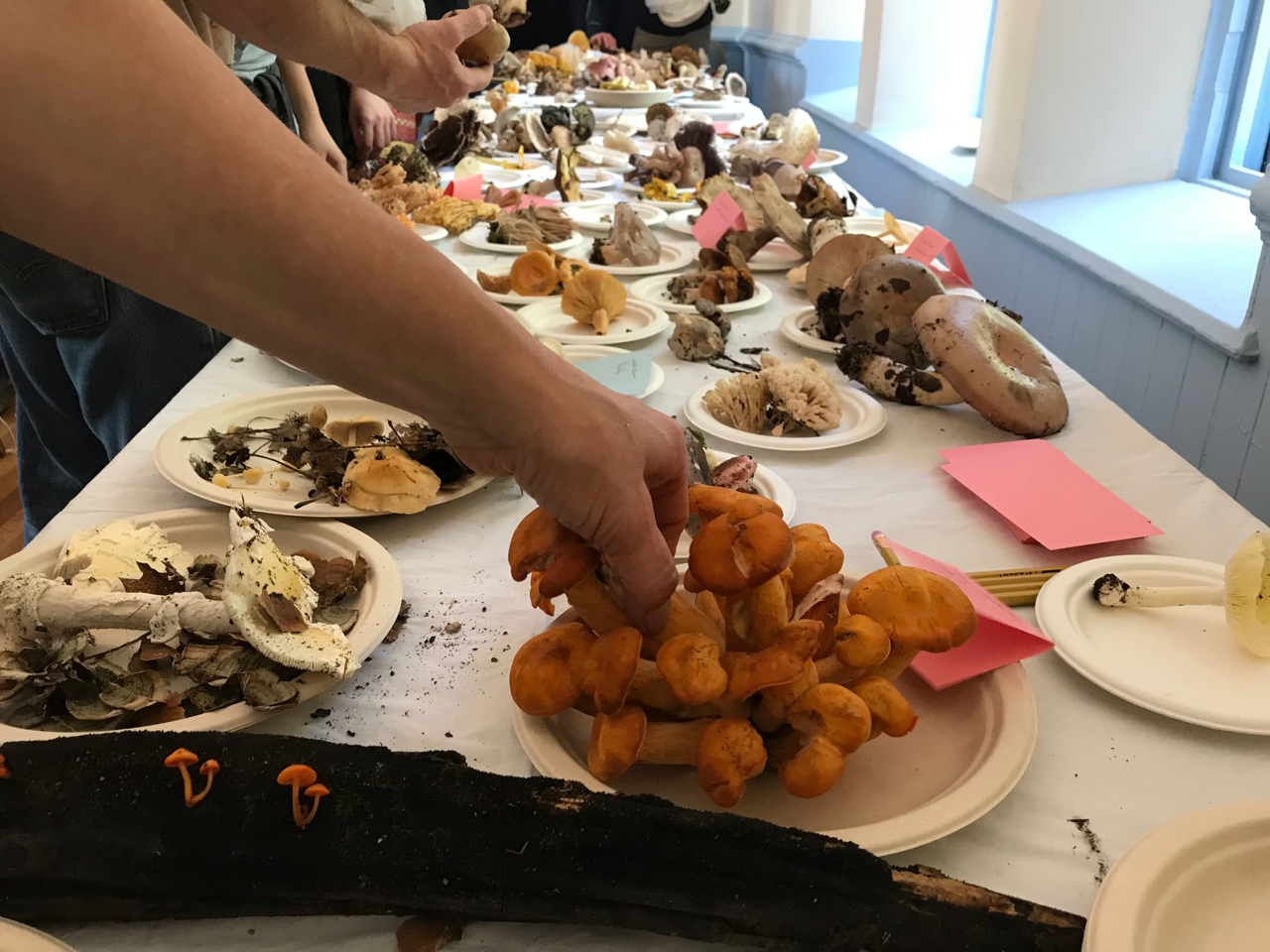
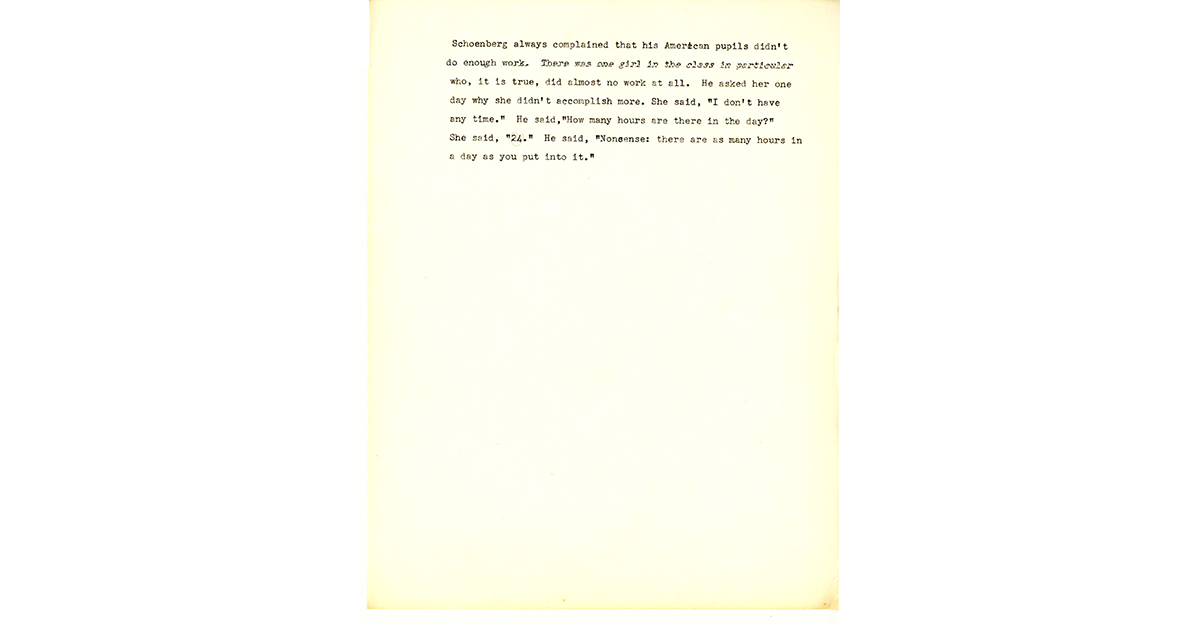
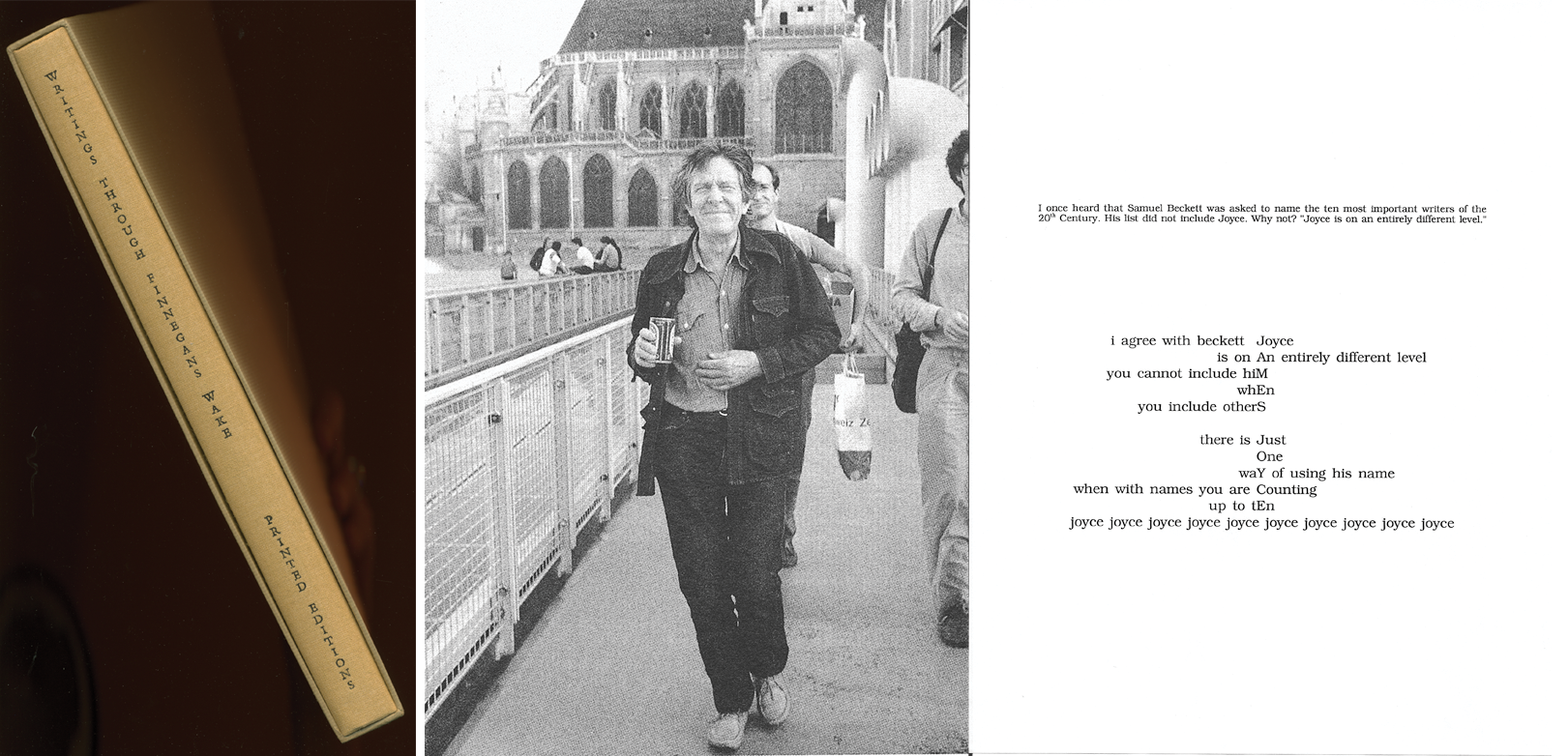

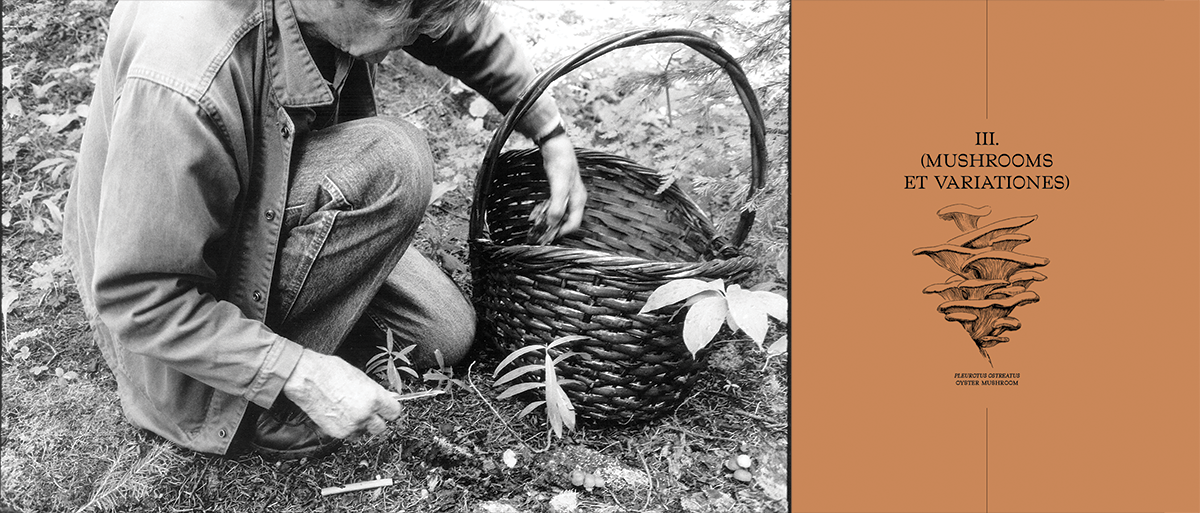


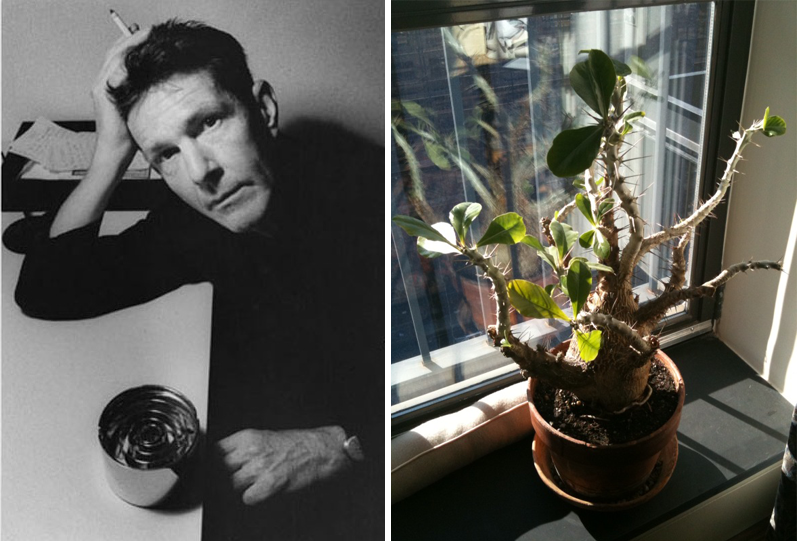
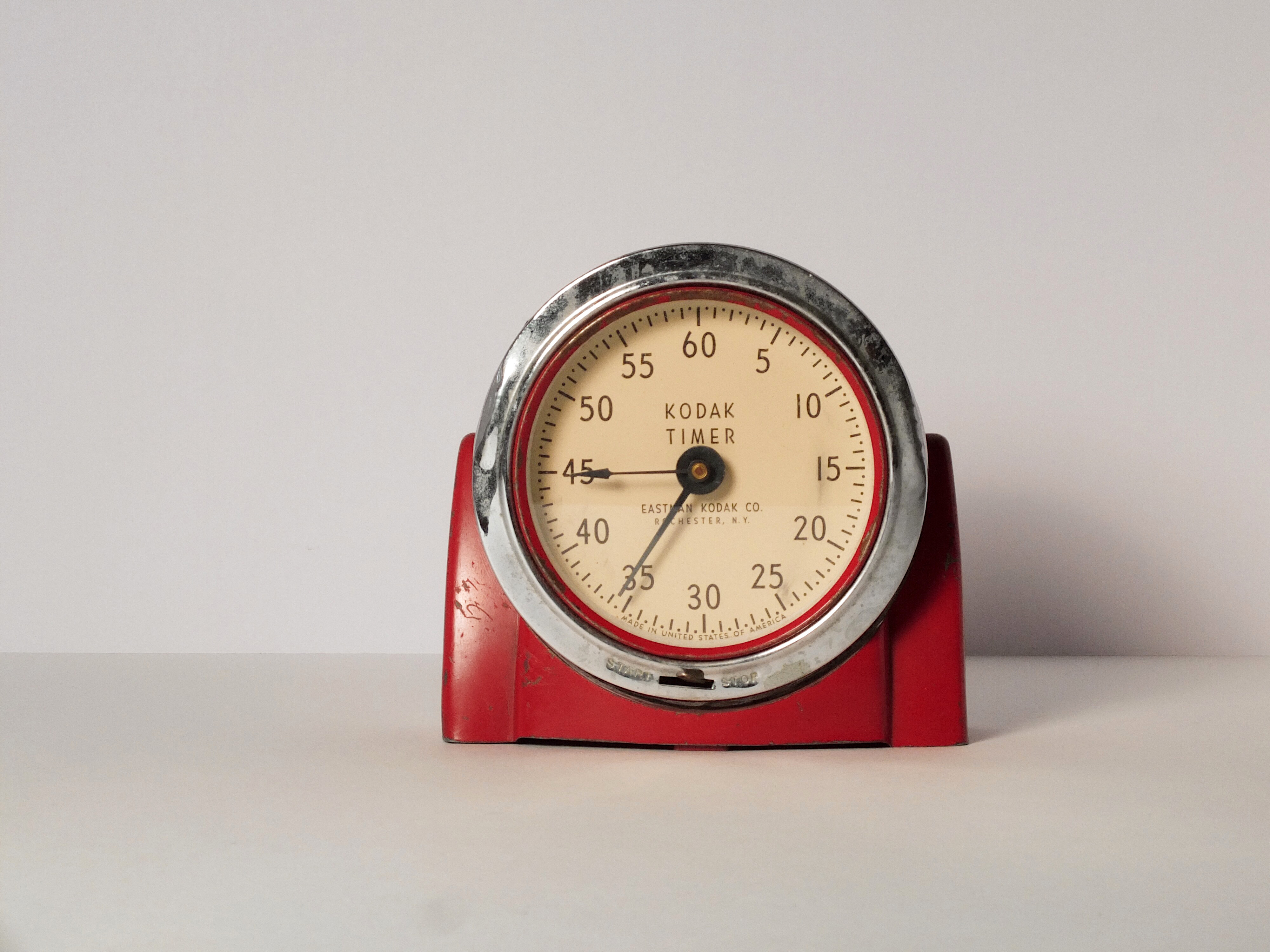
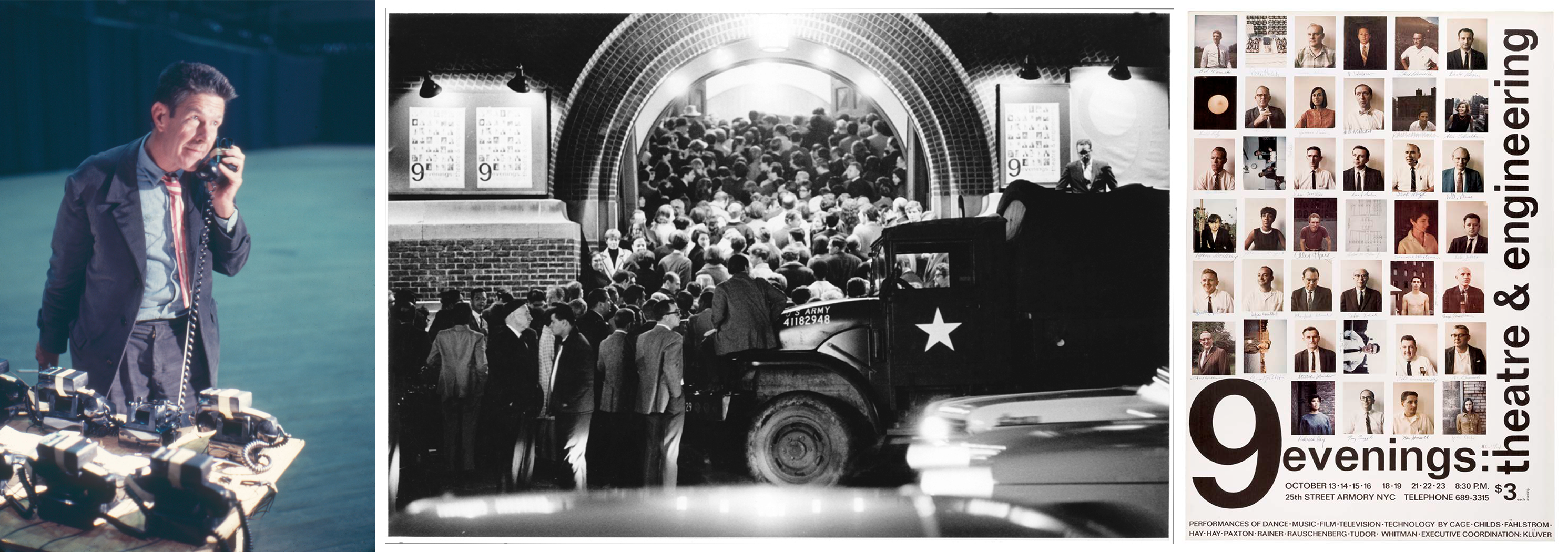
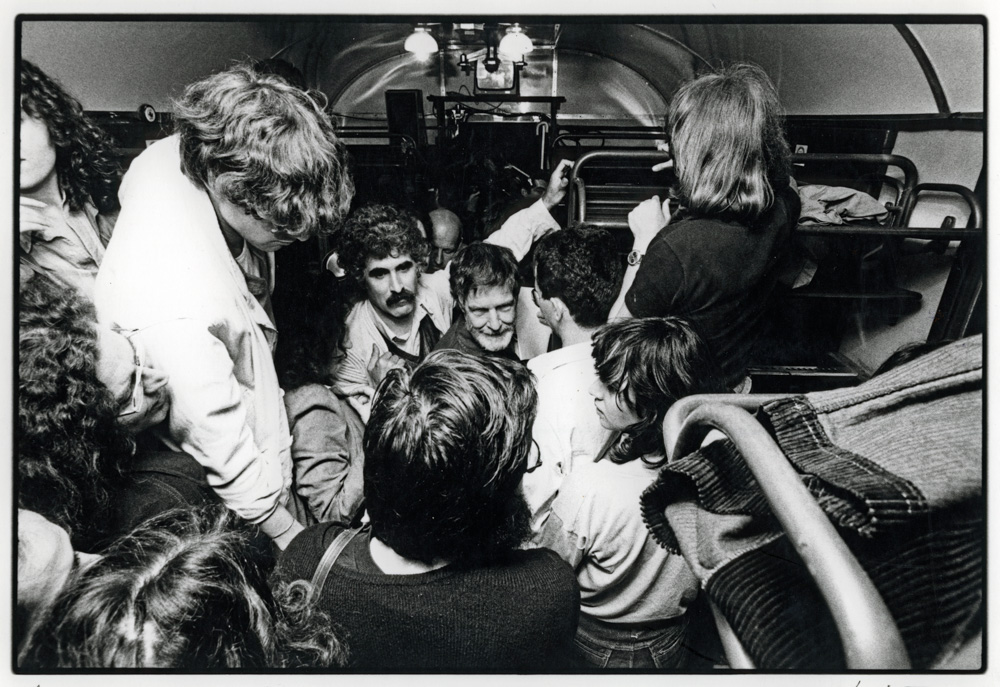
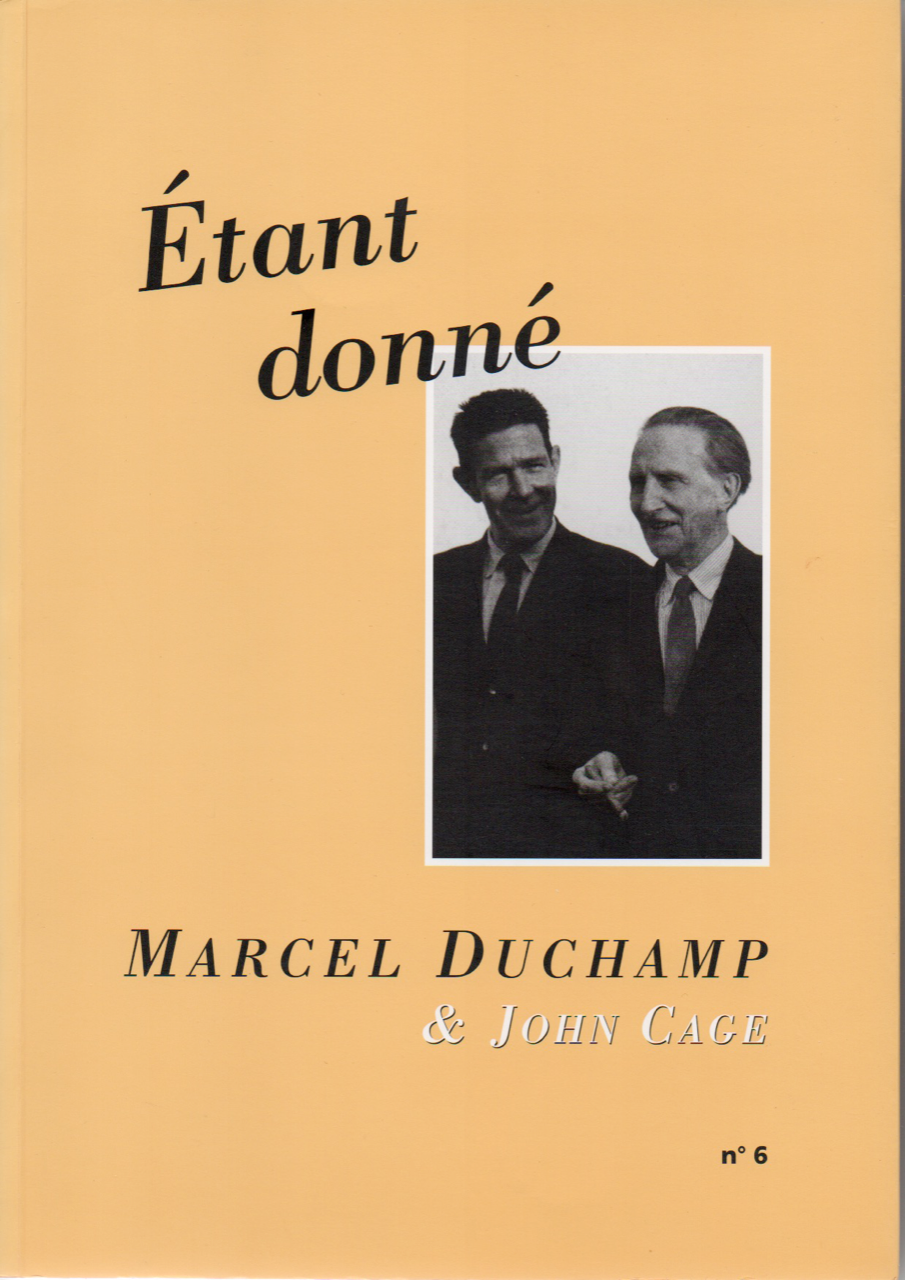
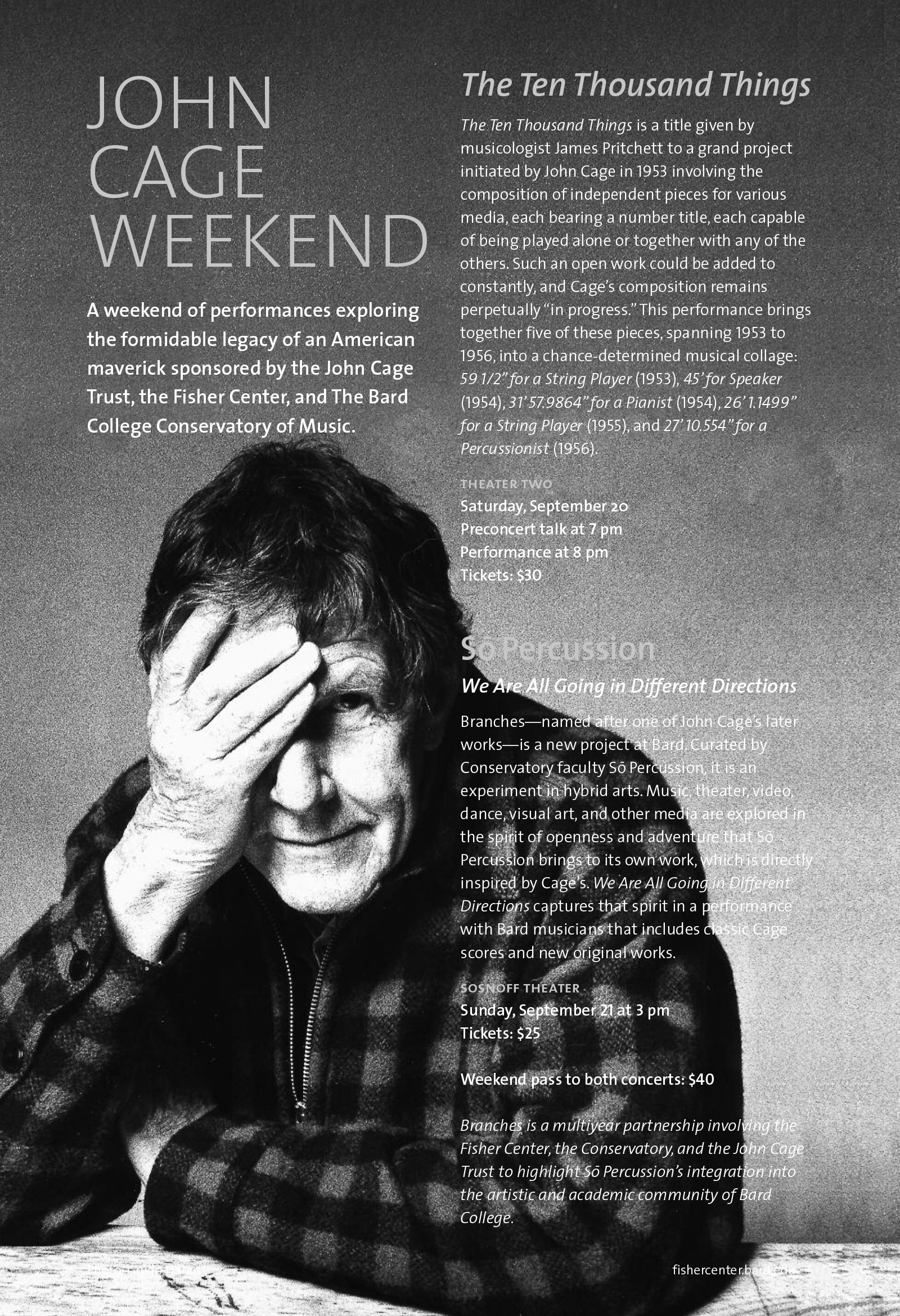
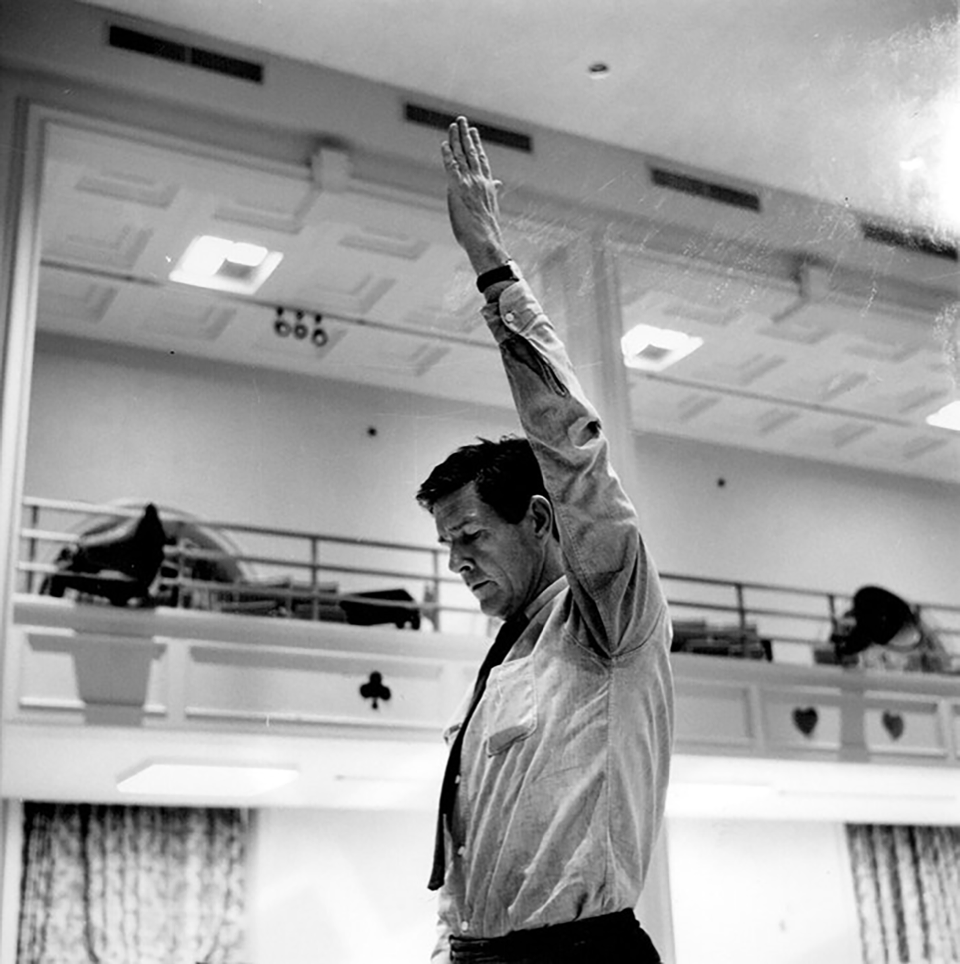
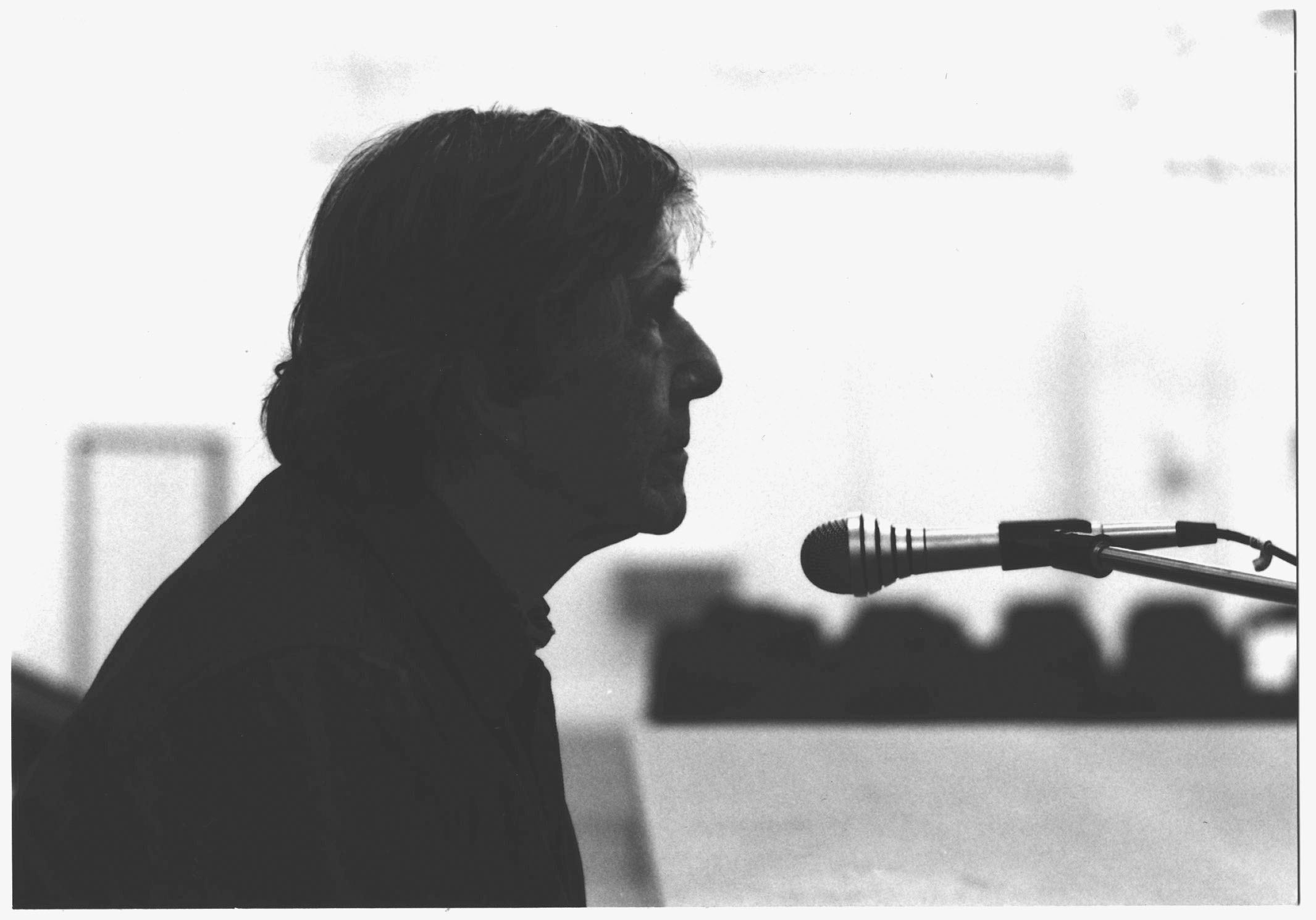
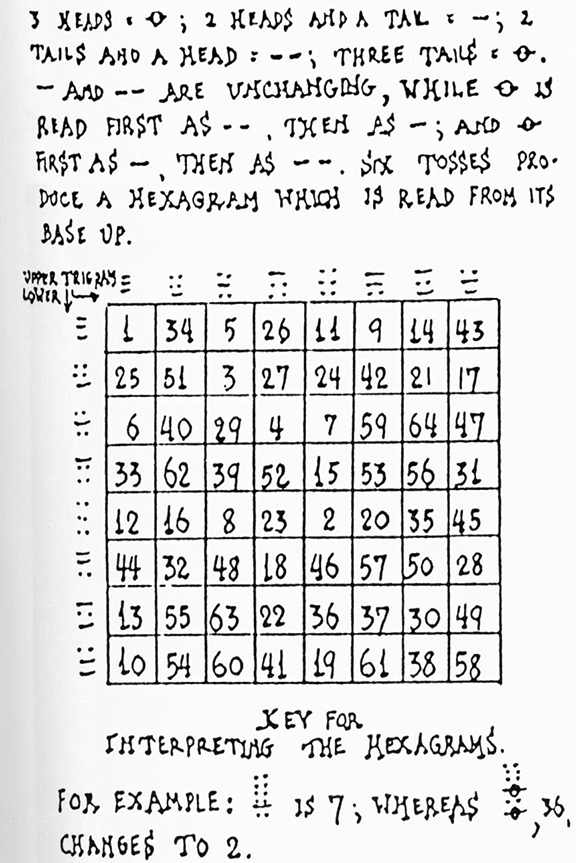
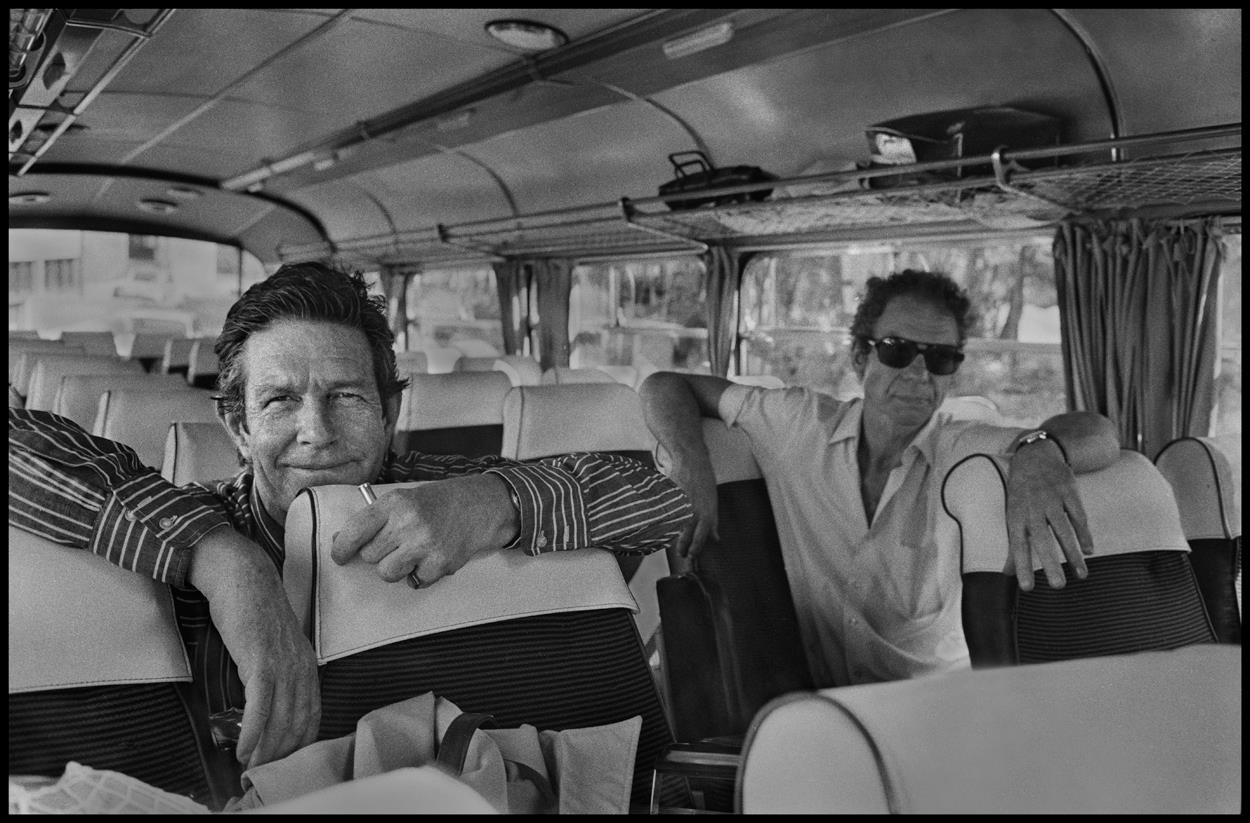
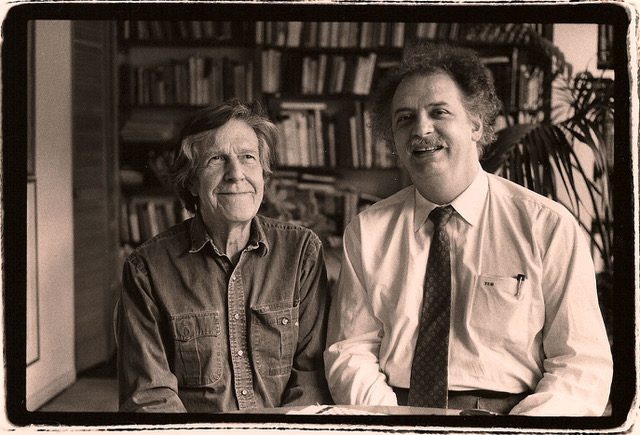
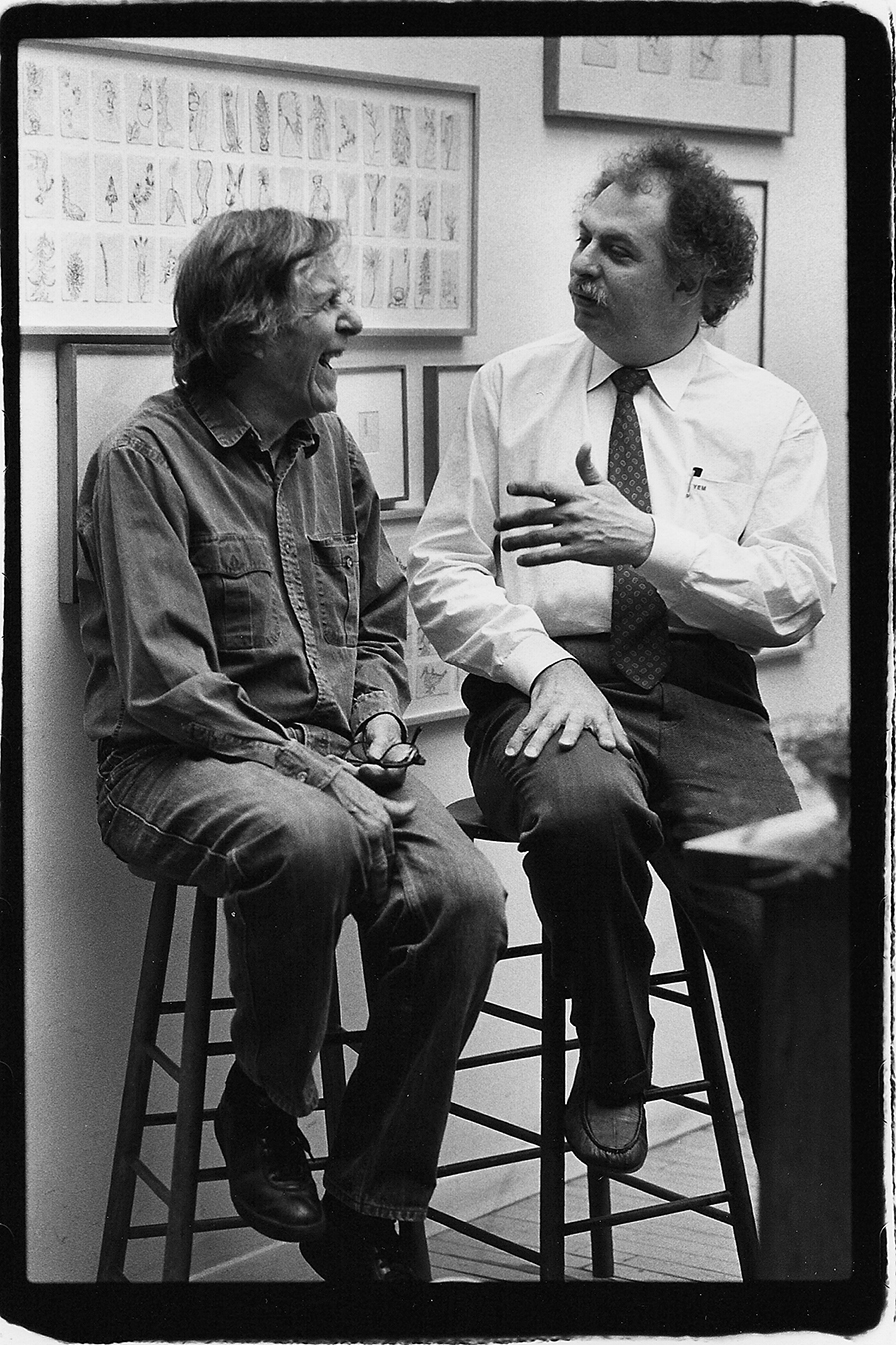
 (David Gahr) bw.jpg)
 ©James Klosty.jpg)
